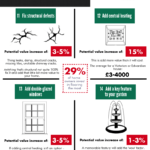A housing bubble is created due to an upturn in housing prices caused by increased demand, speculation and exuberance. However, when this demand eventually subsides, house prices take a sharp downturn.
There are 5 parts to a housing bubble. Displacement is when the demand for property increases due to limited supply, fuelled by low interest rates and more borrowers entering the market. This leads to the eventually boom, when the market begins to inflate as consumer confidence grows, but supply is still slow to increase. Euphoria follows, when house prices begin to skyrocket, and more investment is made into the marketplace and supply gradually increases. The investors take their profit as they heed the warning signs that the bubble may be about to burst. This in turn starts the final stage of the housing bubble – the panic. Housing prices take a huge downturn as demand stagnates because of above average house prices and interest rate rises. The bubble bursts.
We can look at history to work out where we are in the bubble and try to make a prediction as to how the bubble will react to certain events in the market. Over the last 40 years in the UK housing market, there have been two booms and three busts and a lot of fluctuation in between. We can look at these market trends to determine what will happen next. On average, a housing boom tends to last around 8 years.
Warning signs that the housing bubble is about to burst includes rising interest rates, changing lending criteria meaning its harder for people to get cash for a mortgage, decreasing demand. Also, if the average house price is rising faster than your salary, this is one of the biggest signs that we are currently in a housing bubble.
How to Predict a Housing Bubble by Rubber Bond.



![Don’t Buy a Home Without Reading This [Infographic]](https://www.bruzzesehomeimprovements.com/wp-content/uploads/2017/02/First-Time-Home-Buyer-150x150.jpg)
